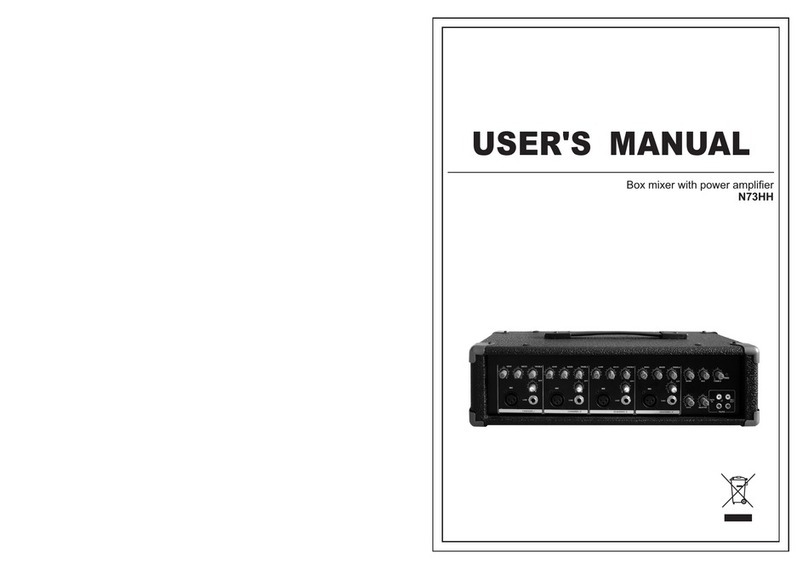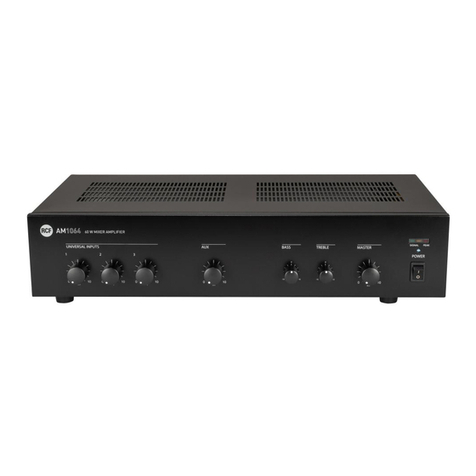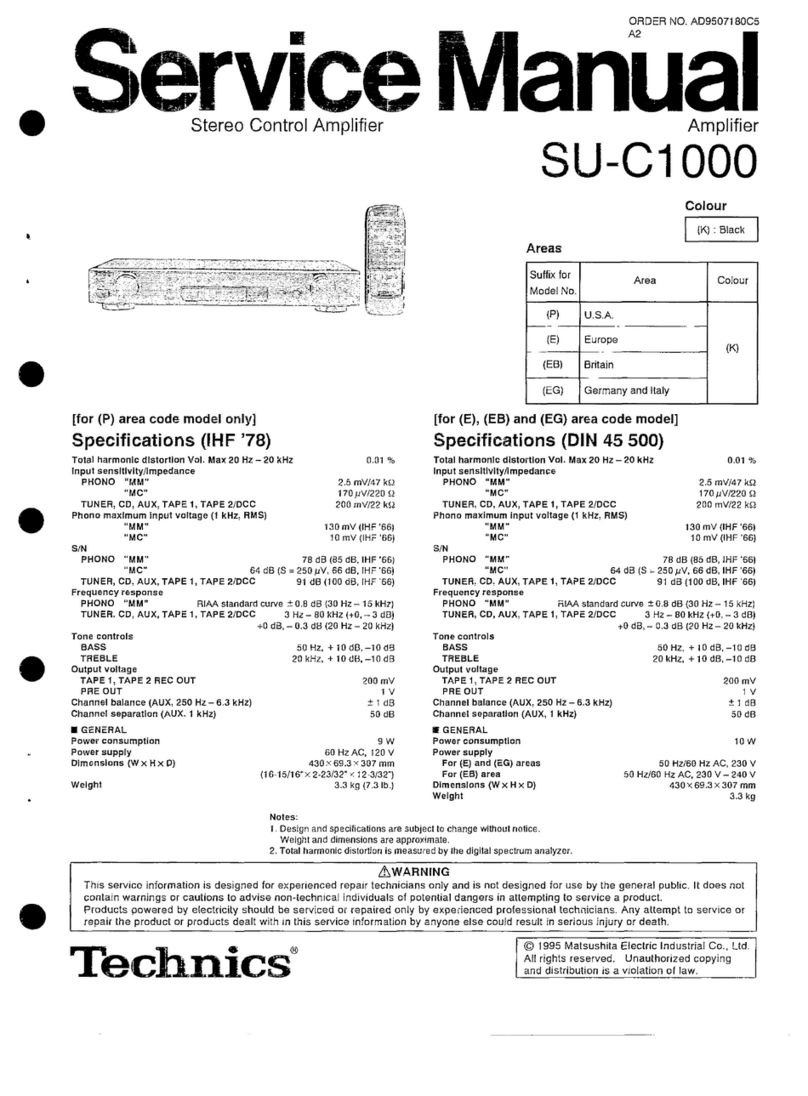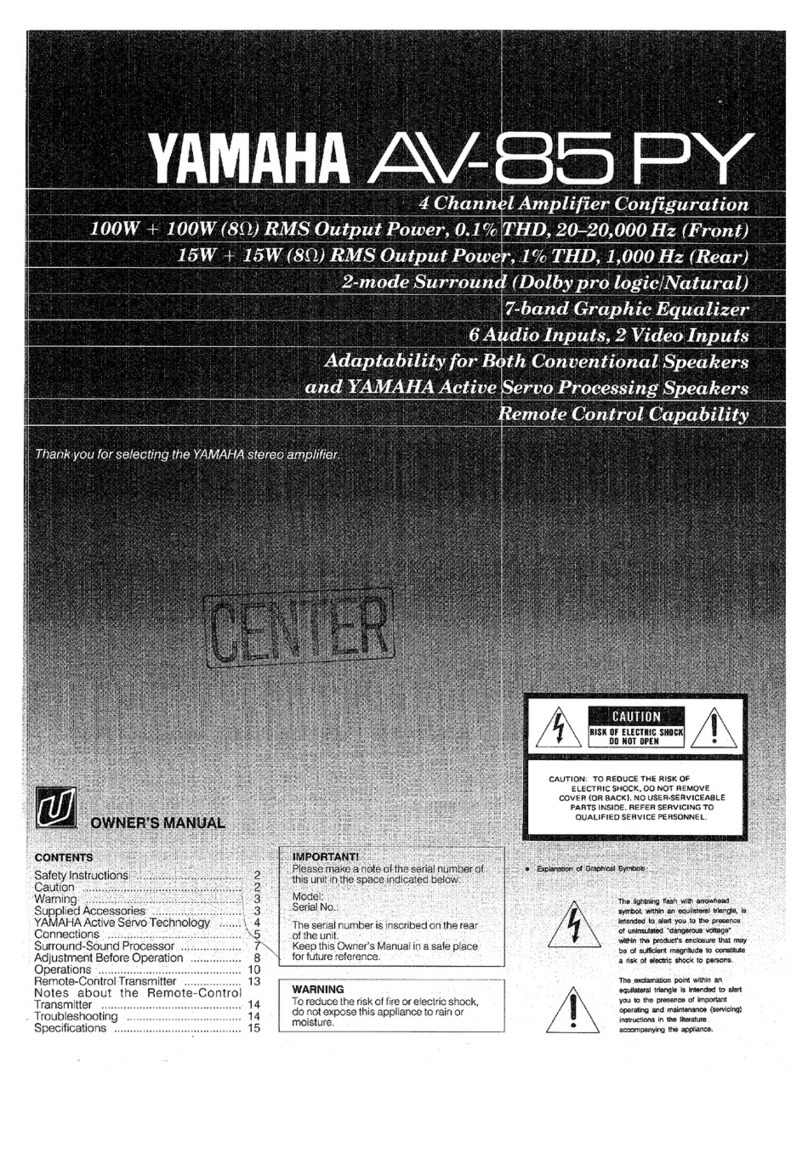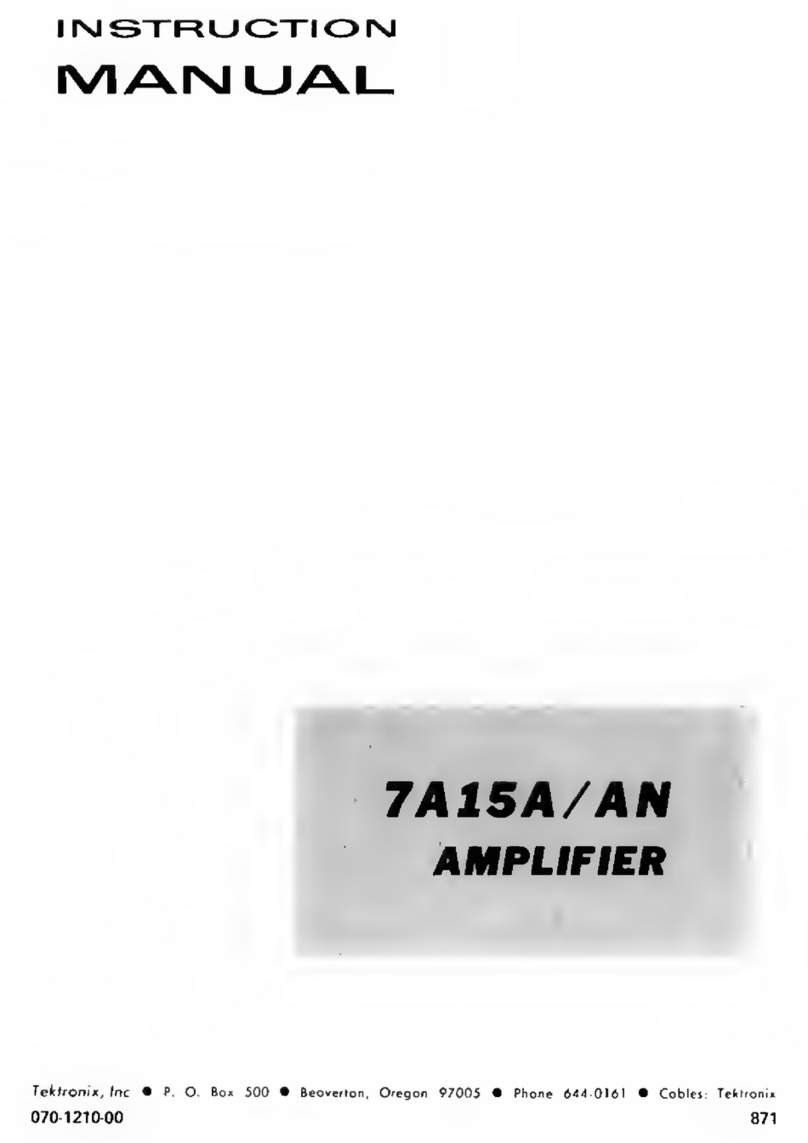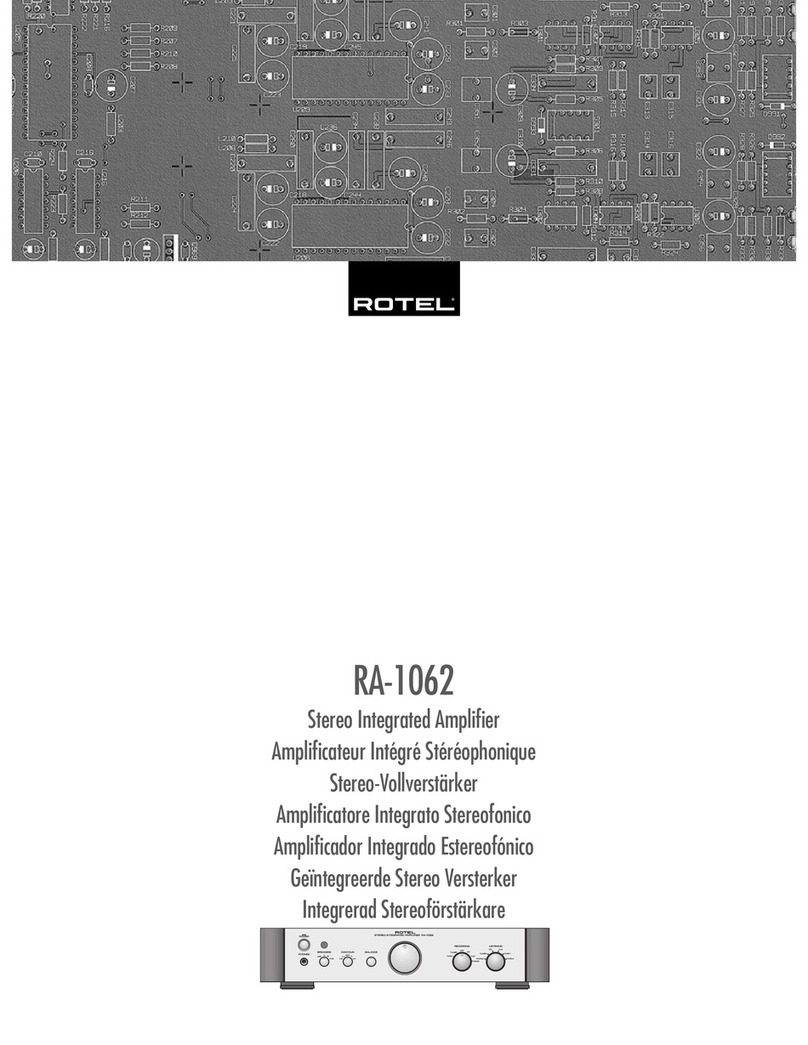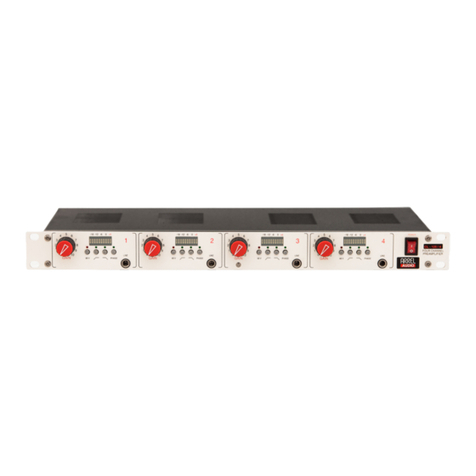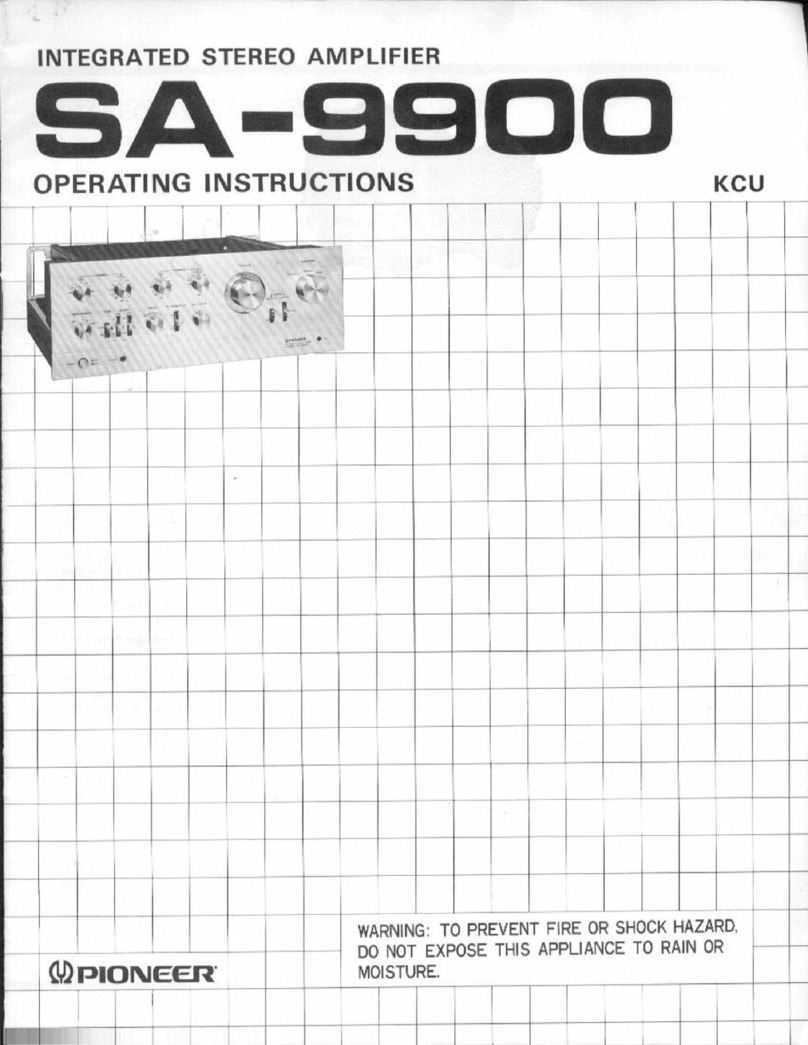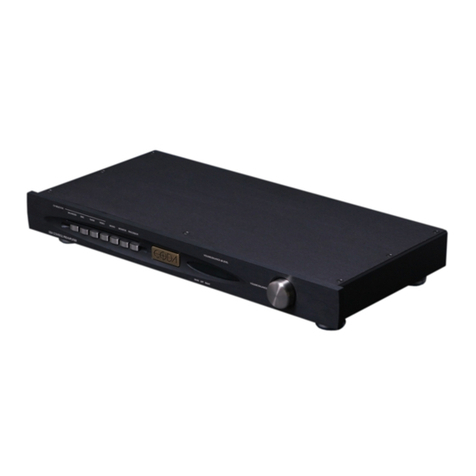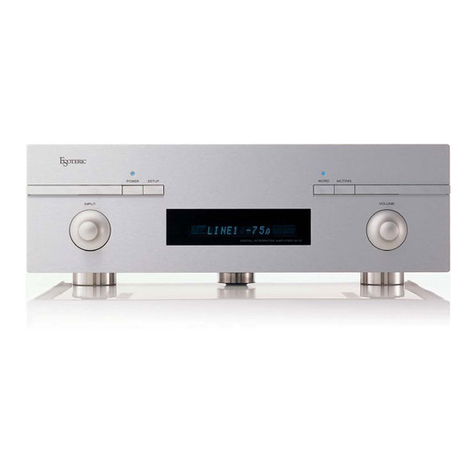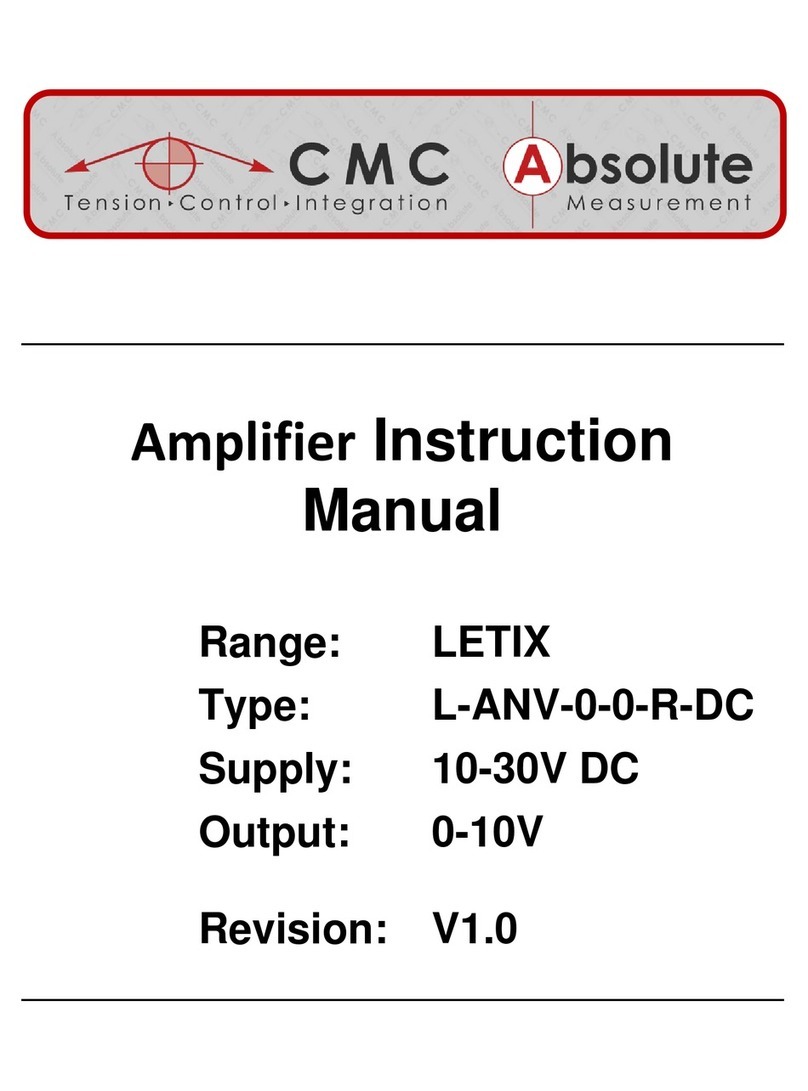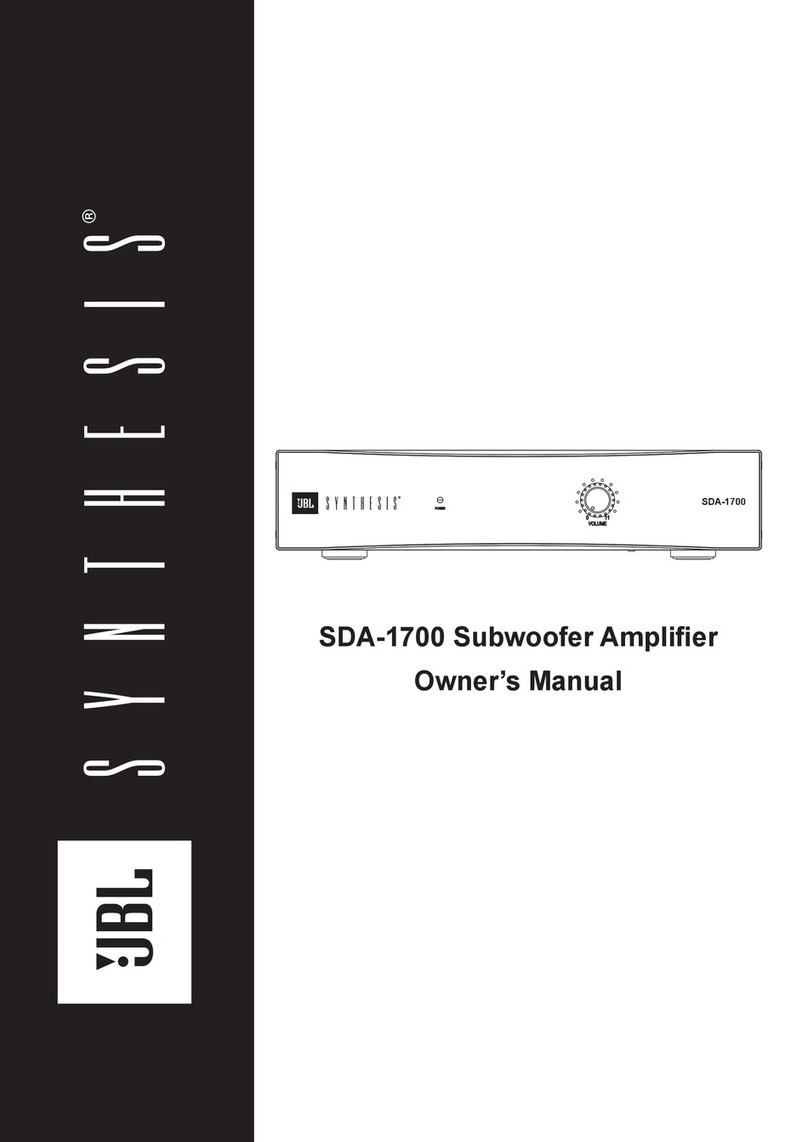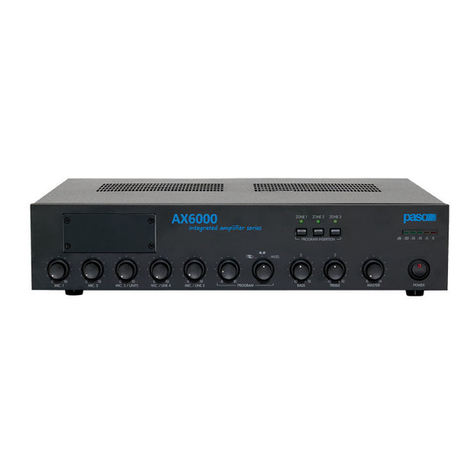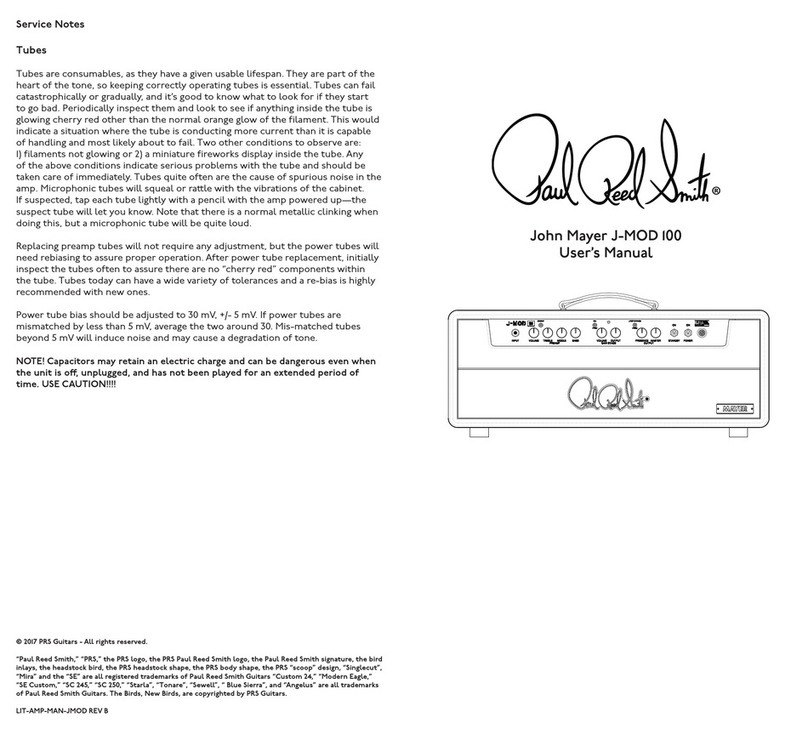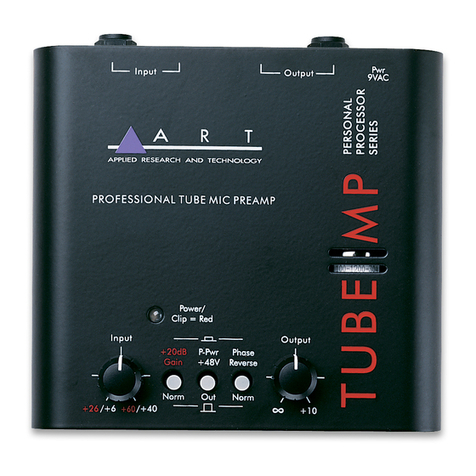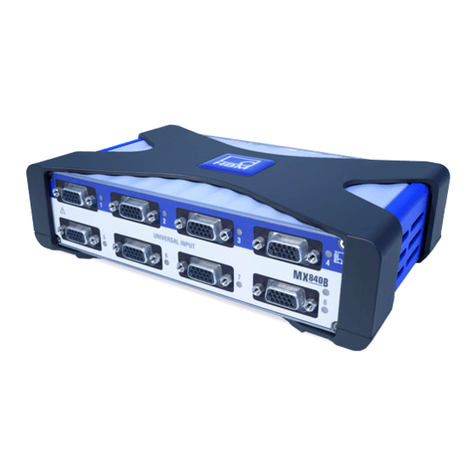ProSound 800 User manual

www.maplin.co.uk
Prosound 800, 1000, 1600 Professional
Power Amplifier Manual
www.maplin.co.uk

Unpacking and Inspection
Carefully unpack the unit. If it appears damaged in any way, return it to the dealer it was purchased from
in its original packaging. Maplin cannot accept any responsibility for damage arising from the use of non-
approved packaging.
Service
All ProSound products are thoughly examined and tested before leaving the factory, and if a correctly used
will give many years of excellent service. However, if a problem arises, proceed as follows:
A) Contact the retailer from whom the unit was purchased and describe the symptoms of the fault.
B) If the retailer cannot help, return the equipment to the national distributor for your country. Use the
original packaging to protect the product from damage. Include a note with the equipment stating
your name and address, details of the problem, Date Code, date and place of purchase.
The unit does not contain any user serviceable parts. For details of spares, accessories and other
products, contact you local retailer. In the event of any difficulty contact ProSound directly via
www.maplin.co.uk
Compliance
This equipment is designed to comply with the following standards:
BS EN55103-1:1996
BS EN55103-2:1997
BS EN60065:2002
Malin Electronics constantly seeks ways to enhance our products, and improvements take place continu-
ally. Whilst every effort is made to produce up to date literature, Malin Electronics limited reserve the right
to alter specifications without prior notice.
- 9 -
Status
Problem
Cure
Power LED is off
No mains or blown fuse
Check mains connections, check switch set to ‘on’ (at socket & amp),
check mains breaker or RCD, replace fuse (See manual for
IMPORTANT SAFETY INFORMATION)
Protect LED is on
Outputs short circuit, or low
impedance load
Check all output connections and total speaker impedance. For stereo
mode, minimum 4per channel, for bridge mode minimum 8. When
problem is cleared press RESET button. DO NOT ATTEMPT TO
HOLD THE RESET BUTTON IN TO DEFEAT ITS PURPOSE !
Temp LED is on
Amp is overheating
Ensure vents are clear, with free airflow front & rear. Ensure signal is
not clipped at amp input or source output. Amp will resume normal
operation after 3-5 minutes.
Bridge LED is on
Amp is in bridge mode with
stereo outputs in use
Use bridge output only (minimum 8) in bridge mode
IF YOUR AMP STOPS WORKING ;
•Turn volume to zero on both channels
• Check all connections (input and output, at both ends of cable)
• Check status lights on front panel
• Disconnect from mains before changing fuse
• Replace fuse only with same type and rating
• If problems persist contact a qualified service agent
• READ THE MANUAL !
.
At the end of its serviceable life, this product should not be treated as household or general waste. It should be
handed over to the applicable collection point for the recycling of electrical and electronic equipment, or returned
to the supplier for disposal.
1. All electrical and electronic equipment without batteries
WEEE Directive & Product Disposal
This symbol on the battery indicates that the battery is to be collected separately.This battery is designed for
separate collection at an appropriate collection point.
2. electrical and electronic equipment that are supplied
with batteries (including internal batteries)
WEEE Directive & Product Disposal
Internal / Supplied Batteries
At the end of its serviceable life, this product should not be treated as household or general waste. It should be
handed over to the applicable collection point for the recycling of electrical and electronic equipment, or
returned to the supplier for disposal.
3. Batteries
Notice to customers
This symbol on the battery indicates that the battery is to be collected separately.
The following apply only to users in European countries.
This battery is designed for separate collection at an appropriate collection point. Do not dispose of as household
waste.
For more information, contact the retailer or local authorities in charge of waste management.

Amp care bullet points.
Amp care bullet points.
DO
1. Read the manual ; understand the operation, limitations and safety instructions before using the
product
2. Use good quality cables of the correct type, in the correct sockets
3. Listen to your sound ; if it’s distorted, reduce gain, volume or both
4. Use adequate amplification and speakers for your needs
5. Checks the mains supply in the venue ; use a mains checker e.g. Maplin product WD53H
6. Ensure your amp, speakers and all cables are free from damage
7. Protect your amp from moisture, smoke/fog machines and glitter cannons
8. Make and check all connections before you switch on
9. Set amp volume to ‘0’ at switch on. Slowly turn up, checking all speakers are working. If there are
problems turn the amp off and resolve them
DO NOT
1. Prevent airflow to your amp ; ventilation is required front and rear
2. ‘Daisy chain’ speakers. Run a maximum of 1x4 Ohm speaker or 2x8 Ohm speaker per amp channel.
3. Run amplifiers with the clip or limit lights on constantly
4. Send a clipped or overdriven signal from your mixer or source to the amp
5. Store your amp or speakers in a damp environment
6. Overload mains sockets ; Never run more than 1500W of amplifiers, lights or other electronic
equipment from one plug socket
7. Connect 2 amp channels, or 2 different amps to one speaker
8. Short circuit or cross-connect an amps inputs or outputs
FOLLOW THE SIGNAL PATH !
• Source output to mixer/preamp input (shielded signal cable),
• Mixer/preamp output to power amp input (shielded signal cable),
• Power amp output to speaker input (unshielded speaker cable).
- 1 -
TECHNICAL SPECIFICATION
- 8 -
Model 800 1000 1600
Stereo mode, 2 x 8Ω
load
150W×2
Max power
800W max@8Ω 1000W max@8Ω1600W max@8Ω
200W × 2 250W × 2
Stereo mode, 2 x 4Ω
load
2 x 300W 2 x 400W 2 x 500W
Rated Output Power (RMS)
Bridge mode, 1 x 8Ω
load
400W x 1 500W x 1 800W x 1
Frequency range 20 Hz - 20kHz
THD >0.5% >0.1 %
Frequency response R
L
= 8Ω, Po = 1 W 0 dB, +0.5 dB, -1 dB f = 20Hz-20kHz
Channel separation ≥70 dB
S/N: 20 Hz-20 kHz >90 dB
Damping factor , R
L
= 8Ω, 1 kHz ≥200
Input sensitivity at rated power 0dBu
Input impedance 30KΩ/balanced, 15KΩ/unbalanced
POWER switch
2 x channel level knob
Front panel
Reset switch
Controls
Rear panel Stereo/Bridge mode switch
2 x &quarter; inch Jack (unbalanced)INPUT
2 x XLR (balanced)
Connections
OUTPUT 3 x Speakon
Power ON 1 x blue LED
Protect engaged 1 x red LED
Over temperature 1 x Orange LED
Signal Clip 2 x Green LED
Signal level 2 x VU Meters
Status Indicators
Bridge mode 1 x green LED
Amplifier protection Over-temperature, short circuit, output DC,
high frequency and over load protection.
Cooling Variable speed brushless fan
120 V, 60 Hz (USA & Canada)
230 V, 50 Hz (Europe)
AC Power supply (factory set)
240V, 50Hz (Australia)
Dimension 485(w)×88(h)×400(d)mm (inc. handles) 19×2U×9
Weight 11.8kg 13.5kg 15.8kg

TROUBLESHOOTING
- 7 -
- 2 -
IMPORTANT SAFETY INSTRUCTIONS
INSTRUCTIONS PERTAINING TO A RISK OF FIRE, ELECTRIC SHOCK OR INJURY TO PERSONS
WARNING - Using electric product, basic precautions should always be followed, including the following:
1. Read all the SAFETY INSTRUCTIONS before using the product.
2. To reduce the risk of injury, close supervision is necessary when the product is used near children.
3. Do not use this product near water - for example, near a bathtub, washbowl, kitchen sink, in a wet
basement or near a swimming pool or the like.
4. This product is capable of producing sound levels that could cause permanent hearing loss. DO NOT
operate for a long period of time at high volume or at a level that is uncomfortable. If you experience any
hearing loss or ringing in the ears, you should consult an audiologist.
5. This product should be located so that its location or position does not interfere with its proper ventilation.
6. This product should be located away from heat sources such as radiators, heat registers or other
products that produce heat.
7. The product should be connected to a power supply only of the type described on the operating instruc-
tions or as marked on the product. Always ensure that a good quality mains lead is used applicable for your
country. The following wiring convention is used in all product mains leads, and must be strictly observed:
Green & Yellow = Earth. Brown = Live. Blue = Neutral. IMPORTANT: THIS UNIT MUST BE EARTHED!
8. This product may be equipped with a polarized line plug (one blade wider than the other). This is a safety
feature. If you are unable to insert the plug into the outlet, contact an electrician to replace your obsolete
outlet. DO NOT defeat the safety purpose of the plug.
9. If the mains fuse need replacing, DISCONNECT THE PRODUCT FROM THE MAIN SUPPLY. The fuse
is below the mains IEC socket, an must be replaced with a fuse of the type and rating stated on the rear
panel. If a replacement fuse fails immediately, contact your local service agent. DO NOT replace with a
higher value.
10. The power-supply cord of the product should be unplugged from the outlet when left unused for a long
period of time. When unplugged the power-supply cord, DO NOT pull on the cord, but grasp it by the plug.
11. Ensure the mains isolation switch is readily accessible when the product is in use.
12. Care should be taken so that objects do not fall and liquids are not spilled into the enclosure through
openings.
13. The product should be serviced by qualified service personnel when:
A. The power-supply cord or the plug has been damaged; or
B. Object have fallen, or liquid has been spilled into the product; or
C. The product has been exposed to rain; or
D. The product does not appear or operate normally or exhibits a marked change in performance; or
E. The product has been dropped or the enclosure damaged.
14. DO NOT attempt to service the product beyond that described in the user-maintenance instructions. All
other serving should be referred to qualified service personnel.
15. WARNING - DO NOT place objects on the product’s power cord or place it in a position where anyone
could trip over, walk on or roll anything over it. DO NOT allow the product to rest on or to be installed over
power cords of any type. Improper installations of this type create the possibility of fire hazard and/or
personal injury.
SAVE THESE INSTRUCTIONS
FAULT
PROBLEM
SOLUTIONS
AC supply not connected or
switched off.
Check AC connections and switches.
No sound
(Power LED off)
Blown fuse
Check and replace fuses at plug and IEC
socket. USE ONLY SAME TYPE AND
RATING !
No input, or input too low
Check input is connected, and VU meters
are showing adequate signal present.
Level controls set too low
Increase level controls
No sound
(Power LED on)
Speakers faulty or not
connected
Check speakers and speaker connections
No sound
(Protect LED on)
Speaker outputs short circuited,
or low impedance load
connected.
Check all output connections, and check
speaker load total impedance. Press reset
button when problem is cleared.
No sound (Temp
LED on)
Amp has overheated
Turn levels to minimum and allow to cool for
5 minutes. Check front and rear vents are
not blocked, check input level is not causing
clip lights to illuminate.
Noise from AC supply is being
picked up in the signal path
Use good quality, shielded signal cables and
ensure they are kept away from AC power
cables and other AC powered equipment.
Hum or buzz is
audible
There is an earth problem
Use a mains tester to ensure the AC outlet
has a good earth. Power connected
equipment (e.g mixer and amp) from the
same AC outlet where possible.
Excessive signal level
somewhere in signal chain.
Use the VU meters to ensure the input level
to the amp is at the correct level. Check
levels at mixer or source
Distortion is
audible
Damaged or poor quality
cables
Use only high quality cables of the
appropriate type, protect them from damage
and regularly check connections.
Sound cuts out
or is intermittent
Damaged or poor quality
cables or connectors,
connectors not properly
inserted, amp overheating
Check all cables and connections, refer to
above sections regarding distortion and
temp warning light.

Prosound 800, 1000, 1600 Professional
Power Amplifier Manual
INTRODUCTION
The PROSOUND series of amplifiers are fully featured rack mount professional power amps, designed
to provide high quality, reliable performance for all professional applications from live bands to club
installations.
MAIN FEATURES
• Class AB design for high reliability and low distortion
• Cooling path is designed to prevent dust and dirt build up inside the amplifier, preventing PCB damage
and maintaining maximum cooling effect for greater reliability in operation
• Variable speed, brushless fan to improve cooling, reduce noise and increase fan life.
• Comprehensive protection circuitry protects the amp from over-current, short circuit, over-temperature,
DC and high frequency problems to prevent down time for repairs.
• Over-engineered power supplies for improved depth and dynamic response.
INSTALLATION GUIDELINES
• Do not use these amplifiers in damp or high humidity environments. Do not use outdoors, or anywhere
where liquids could fall or splash onto the amplifier.
• Ensure the amp is adequately ventilated, with free airflow to the front and rear panels. Keep away from
other heat sources. If the amps are mounted in a rack with other amps, ensure there is adequate cool
air flow front and rear. Note that air is drawn in through the back panel, and exhausted through the
front panel.
• NEVER cover the amplifiers, as they may overheat.
• Prosound power amplifiers are designed to fit standard 19” racks, with a 2U height and 17” depth. We
recommend the use of rear rack supports, especially if the rack is to be mobile. Use shakeproof
washers or threadlock adhesive to prevent mounting bolts becoming loose in transit.
• Ensure that the AC power supply is correct for your amplifier. The required AC supply is stated on the
rear panel next to the AC power input.
• Ensure that you use the correct type of mains lead for your equipment and country. This must be free
from damage, and easily accessible during use.
• Keep away from magnetic recording media (tape, mini disc, hard drive etc). Power amps produce an
electromagnetic field, which could affect stored files.
- 3 -
9. AC socket. Connect the supplied AC power lead here. Ensure the correct AC supply is used, as stated
on the rear panel.
10. AC Fuse. The AC power fuse is located in the drawer above the AC socket. Should the fuse fail,
replace only with the same type and rating. DO NOT replace with a higher value. If a replacement
fuse fails immediately, contact a qualified Service Engineer. Disconnect the amplifier from the AC
supply before attempting to change the fuse.
Wiring Conventions in ProSound Power Amps
Balanced XLR ; Pin 1=Signal ground. Pin2=IN phase signal . Pin 3=OUT phase signal.
Unbalanced XLR ; Pin 1= Signal ground. Pin2= Signal psoitive. Pin 3=Signal ground (common with 1).
¼” TRS balanced jack ; Tip=IN phase signal . Ring=OUT phase signal. Sleeve=Signal ground.
¼” unbalanced jack ; Tip=Signal Positive. Sleeve=Signal ground.
Speakon ; 1+=Speaker positive. 1-=Speaker negative. 2+=Common with 1+. 2-=Common with 1-.
- 6 -

9. Bridge LED. This LED illuminates to show that mono bridge mode has been selected on the rear
panel. Channel A level only is active, and speaker loads should be connected for bridge mode
operation as described below.
10. Clip LED (one per channel). This illuminates when the input signal is clipping, or within 3dB of
clipping. In normal use this should illuminate briefly only on signal peaks. If it illuminates constantly,
or most of the time reduce the input signal level.
11. Power LED. This illuminates to show the amplifier is connected to AC power and switched on. When
the amplifier is switched off this will slowly dim and extinguish.
Rear panel features
1. Channel A XLR input socket. This accepts line level balanced or unbalanced signal. Use this input for
Channel A in stereo mode, or for mono bridge mode operation.
2. Channel A TRS jack input socket. This accepts line level balanced or unbalanced signal. Use this
input for Channel A in stereo mode, or for mono bridge mode operation.
3. Channel B XLR input socket. This accepts line level balanced or unbalanced signal. Use this input for
Channel B in stereo mode. This input is not used in bridge mode.
4. Channel B TRS jack input socket. This accepts line level balanced or unbalanced signal. Use this
input for Channel B in stereo mode. This input is not used in bridge mode.
NOTE ; Always use good quality shielded cables for all signal connections. Keep signal cables away
from speaker cables, AC power cables or other high current carrying cables.
5. Mode switch. This switch can be set to Stereo (Channel A and channel B active and independent) or
Bridge (amplifier works as a single mono amplifier) mode.
6. Channel A speaker output socket (Speakon). Connect speakers with a total impedance of not less
than 4 ohms to this socket when in stereo mode only. The output level is controlled by the Channel A
volume control on the front panel
7. Channel B speaker output socket (Speakon). Connect speakers with a total impedance of not less
than 4 ohms to this socket when in stereo mode only. The output level is controlled by the Channel B
volume control on the front panel
8. Bridge mode speaker output socket. Connect speakers with a total impedance of not less than 8 ohms
to this socket when in bridge mode only. The output level is controlled by the Channel A volume
control on the front panel.
NOTE ; Use low resistance, unshielded high power speaker cables to connect the amplifier to your
speakers. Keep the cables as short as is practical, and keep them away from the input signal cables
- 5 -
OPERATION
Front panel features
1. Exhaust vent. This vent must be kept free from obstruction, to allow hot air drawn through the amplifier
to exit. During use warm air will blow from this vent.
2. Channel A level (volume) control. In stereo mode operation this controls the amplifiers power output on
Channel A. In bridge mode this controls the amplifiers bridged output. We recommend setting this to
maximum during use to give best headroom and dynamics. Overall level should be controlled from your
mixer or audio source.
3. Power switch. This switch turns the amplifier on. When switched to ‘OFF’, the internal circuit is isolated
from the AC supply.
4. Channel B level (volume) control. In stereo mode operation this controls the amplifiers power output on
Channel B. In bridge mode this control is inactive and should be set to zero. We recommend setting this
to maximum during stereo operation to give best headroom and dynamics. Overall level should be
controlled from your mixer or audio source.
5. VU meter (one per channel). This meter shows the level of input signal, and will fluctuate during use with
signal level. The output level of your mixer or audio source should be set so that the needle swings into
the red zone only on signal peaks. If the needle is usually in the red zone, the input level should be
reduced at the source to prevent distortion and overheating.
6. Reset button. If the amplifier output is short circuited, or a low load impedance is connected, the ‘Protect’
LED (7) will illuminate and amplifier output will be shut down. If this happens, check that the outputs are
properly connected to a suitable load, using good quality, undamaged cables. Turn the volume controls
to zero, and press the reset button. The amplifier should return to normal operation.
NOTE ; If the amplifier keeps returning to protect mode, check all connections and speaker impedances.
If the amplifier will not operate when correctly connected to a suitable load contact a qualified Service
Engineer. DO NOT attempt to hold the reset button in to defeat the protection. Serious damage could
occur.
7. Protect LED. When this LED illuminates, the onboard protection has cut in, disabling the amplifier to
protect it from fault conditions. If this illuminates, turn the amplifier off and check all connections and load
impedance.
8. TEMP LED. When this LED illuminates, the onboard over temperature protection has cut in, disabling
the amplifier to protect it. This will occur if insufficient ventilation is available, or the amp is being
overdriven. If this illuminates, turn the level controls to miniumum and check ventilation to front and rear.
The amplifier will return to active mode after a few minutes to cool down. When restarting the amplifier,
check the input signal levels using the VU meters, as described in 5 above.
- 4 -
This manual suits for next models
2
Table of contents
Other ProSound Amplifier manuals
